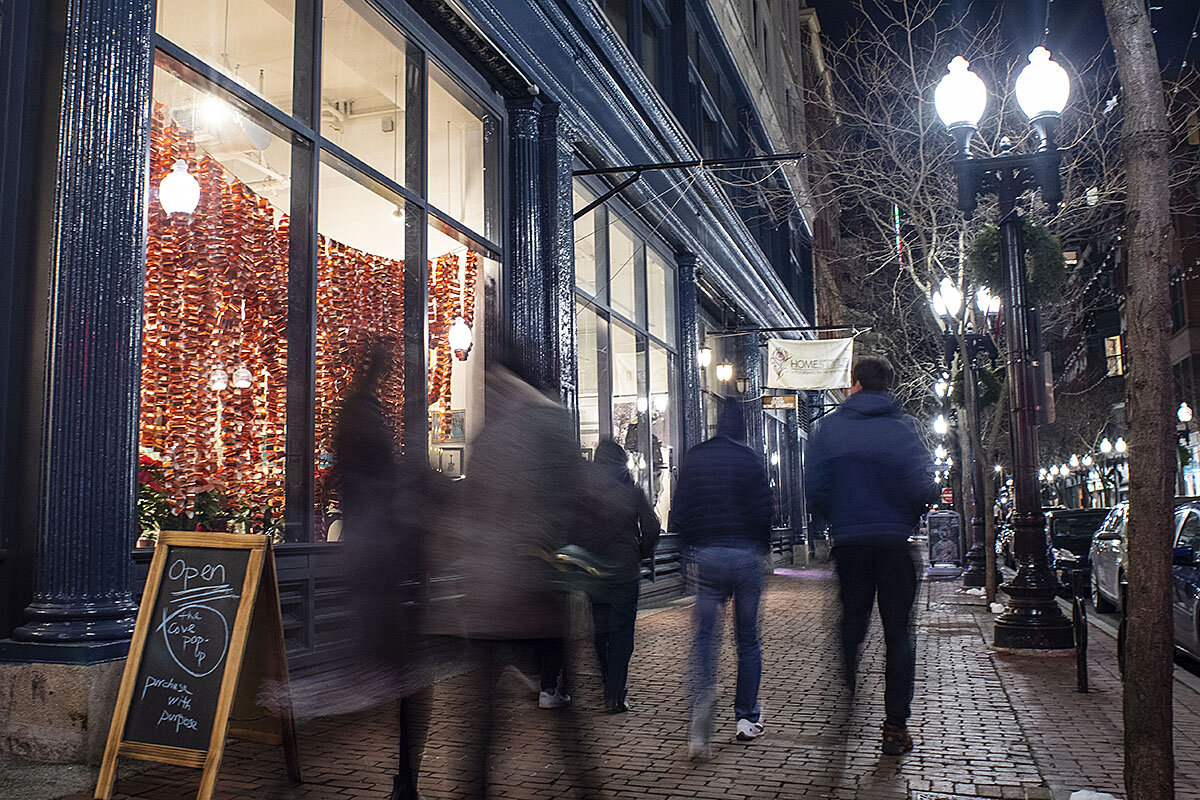The ‘other 9 to 5’: Cities see nightlife from a new angle
Loading...
| Providence, Rhode Island
Nightlife is messy – residents complain about noise; workers lack efficient public transit; business owners face licensing hurdles; wherever alcohol and crowds mix, there will be safety concerns – and the struggle to balance everyone’s needs is far from new.
But cities looking to solve several problems at once are dedicating resources to nighttime alone. Pittsburgh was one of the first U.S. cities to adopt the strategy, hiring someone – sometimes called a “night mayor” – whose job is to improve public safety, economic opportunity, and quality of life during “the other 9 to 5.” The city has seen notable improvements over the past five years as a result.
Why We Wrote This
Seeing opportunity in its problems led the city of Amsterdam to create the first “night mayor” position in 2012. Providence, Rhode Island, is considering the investment after a string of incidents around nightclubs.
“The overarching idea is to have somebody that has the pulse on what’s happening at night,” says Allison Harnden, Pittsburgh’s nighttime economy manager, “and can either advocate for those changes or actually work on implementing them.”
The after-hours “are really something that have to be planned, rather than policed,” for “a much more successful social economy,” says Jim Peters, of the Responsible Hospitality Institute, “which is what a lot of people who are living in cities want.”
Anthony Santurri surveys the scene at Free Play Bar Arcade in Providence, part of a two-story venue that he has operated with his business partner for the past decade. On the first floor, friends mingle among pinball and Pac-Man, chatting over a steady stream of 1980s hits. Upstairs, people flock to a dance floor monitored by various security guards: someone by the fire escape, one near the DJ, a floater. There are 12 guards total, plus 65 cameras, police detail, and at least one owner on the premises at all times.
Mr. Santurri credits the club’s success, in part, to intense safety standards. He’s even drawn up a 20-page manual of best practices that touches on everything from licensing to counterterrorism, and is proud of the safe environment he’s created for people to “decompress and destress” for a night. “That’s the value of entertainment and nighttime economy businesses,” he says.
Lawmakers are beginning to see the value, too. In Providence, city officials have launched a campaign to appoint the city’s first “night mayor” – a colloquial term for someone whose job is to improve public safety, economic opportunity, and quality of life during “the other 9 to 5.” Cities around the world, including at least nine in the United States, have created similar government roles under titles like “nightlife business advocate” and “nighttime economy manager.” And they serve as anything from conflict mediators to city cheerleaders.
Why We Wrote This
Seeing opportunity in its problems led the city of Amsterdam to create the first “night mayor” position in 2012. Providence, Rhode Island, is considering the investment after a string of incidents around nightclubs.
“Once you get people to see that the issues and the opportunities at night are really something that have to be planned, rather than policed, then you’re going to have a much more successful social economy,” says Jim Peters, president of the Responsible Hospitality Institute (RHI), a national organization based in Santa Cruz, California, “which is what a lot of people who are living in cities want.”
Nightlife is messy – residents complain about noise; workers lack efficient public transit; business owners face state and local licensing hurdles; wherever alcohol and crowds mix, there will be public safety concerns – and the struggle to balance everyone’s needs is far from new.
In the 17th century, for example, Puritans in Massachusetts Bay Colony banned celebrations of Christmas for an entire generation because of rowdy revelers. At the turn of the 20th century, citizen groups in New York and New England worked to eliminate prostitution and gambling by hiring investigators to file police reports on alleged illegal activity.
Today, night mayors are intended as a collaborative approach to safer environments after dark. The concept originated in Amsterdam, which appointed Mirik Milan as the city’s first nachtburgemeester (night mayor) in 2012. Through innovative programs and community building, Mr. Milan reshaped Amsterdam’s nightlife and became an urban planning celebrity in the process. Municipal governments from Seattle to Tbilisi took note and soon followed suit.
Dedicated to the dark
Pittsburgh, where Allison Harnden serves as the city’s nighttime economy manager, was one of the first American cities to adopt the strategy, and it’s seen notable improvements over the past five years as a result.
One neighborhood invested in security training and street clean-up crews using fees collected from a parking meter pilot program. It even paid for portable toilets on Saint Patrick’s Day. Ms. Harnden has also helped business owners navigate convoluted tax codes and is working to better understand and address nighttime noise complaints on the city’s 311 phone line.
“The overarching idea is to have somebody that has the pulse on what’s happening at night and can either advocate for those changes or actually work on implementing them,” says Ms. Harnden.
But nightlife management comes with some unique challenges, as well.
Several night mayors say they spend significant time convincing people that they’re not law enforcement officials. Nightlife industries are also very trend-driven, and something like a new ride-sharing app can solve long-standing issues – or create more problems – overnight. To help each other troubleshoot, Ms. Harnden hosts regular conference calls with all nine night mayors based in the U.S. Every city is unique, but it isn’t hard to find common ground.
For cities considering a night mayor position, Mr. Peters of RHI says it’s important to consider what goals and resources that person will have. A lot of places are looking for “a magic wand” to fix all their problems at night, he says, but this role is also about creating opportunities and growth.
Turning trouble around
In Providence, it was a string of violent incidents around nightclubs that prompted a serious look into the benefits of a night mayor. City Councilwoman Kat Kerwin and school board member Travis Escobar launched the PVD After Dark campaign to explore solutions.
Ms. Kerwin wants to find a night mayor who can first address public safety concerns, then focus on supporting young creatives in the city and streamlining licensing for small businesses. To her, a vibrant nightlife is a need-to-have, not a nice-to-have.
“As a city, we have really serious problems that we have to deal with,” she says, citing an unfunded pension liability and failing school system. “If we’re building our tax base ... and making great minds stay here because the quality of life is too good to refuse, then we’re going to be definitely investing in some of our other public infrastructure.”
The PVD After Dark team is collecting information through an online survey, and plans to hold public forums to learn more about the community’s needs. They also hope to work with Frank LaTorre, executive director of the Providence Downtown Improvement District and local night mayor expert.
For more than a decade, Mr. LaTorre has been addressing quality-of-life issues downtown. When he started, he says the knee-jerk reaction to any after-hours violence was to add a bunch of police and blame all the “terrible, scurrilous nightclub owners.” There was no nuanced conversation about what led to those incidents or how they could be prevented.
Recent efforts like the PVD After Dark campaign, plus other conversations with the mayor and license board, are giving him hope.
“The amount of discussion going on for me, 10 years ago, would have been a dream,” he says.
But talking about a night mayor and actually investing in the position are different. To move the process forward, Mr. LaTorre says Providence needs to establish a nighttime task force that brings together all stakeholders. The city council tried creating a similar team four years ago, but it lost momentum and was never fully implemented.
One of the task force’s main responsibilities, says Mr. LaTorre, will be completing an economic impact study to gather hard data on the current and potential value of Providence’s “life at night.”
These studies have been crucial for other cities with a night mayor. San Francisco’s study found that nighttime businesses generated $4.2 billion in spending and created 48,000 jobs.
Mr. Santurri agrees on the task force, but says there are smaller, incremental steps that Providence should take before investing in a full-time night mayor. He wants the city to commit to adding more police officers, and would like to see his best practices guide turned into a living document that other business owners could use and contribute to as needed.
Others argue that a night mayor – maybe someone like Mr. Santurri, whose decades of experience with nightlife and local government resembles the typical resume – could drive such changes. They say its time for nighthawks to get a seat at the table.
“Let’s say that our nighttime economy became so stellar that it really is getting a good buzz, right?” Mr. LaTorre says. “People will come down from Boston and come up from New York, and people would say, ‘Have you ever been to Providence for a weekend? … It’s amazing.’”










